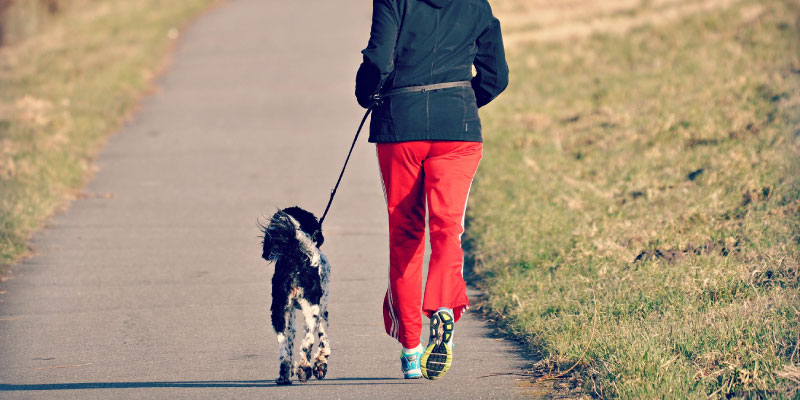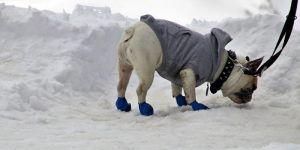Looking after a dog is no walk in the park. For some owners, this phrase can be taken quite literally – they may bring their four-legged companions with them as they gear up their fitness.
Whether you’re training for a marathon or just looking to improve your heart health, your dog could be the motivation you need. Before you start your new routine, ensure you read our tips on how to run with a dog safely.

If you want to a good running program, keep reading our site for more tips.
Why should I start running with my dog?
From building relationships to focusing on your health, there are myriad benefits to pounding the pavement with your pup.
A better bond
Getting out and doing the same walk every day can be tiresome, so much so that you may be tempted to skip it! A run with your dog can serve a purpose, giving you more incentive to go out, and building the bond between the two of you.
Getting a sweat on
There’s no need to fork out hundreds of pounds on a gym membership – all you need is a dog and some good trainers. Running with your dog is that extra motivation you need when you can’t face it on a morning. It saves you time and there’s no traffic driving to the gym. Endless benefits!
Improving your dog’s sleep cycle
Like most people, you probably have to leave your dog at home on its own for some part of the day. Or maybe you just have a super energetic dog breed. By starting out early with a good tiring run, you can set your pup up for a nap. You’ll reduce separation anxiety and pooch will be ready for another walk when you’re back at home.
Improving both your health
Whilst no two dogs are the same, one cliche is true: it’s easier to make your dog fat than to get him lean. Dogs love to eat, and there’s nothing like exercise to help keep them healthy, build muscle, and avoid expensive Vet bills later on in life. What’s true for you, is true for them: running will keep you fit and make you happy.
What are the best running dogs?
Naturally, some dogs are more accustomed to running than others. You’re unlikely to see a Chihuahua pounding the streets, whilst some giant breeds may struggle long term with joint aches! Based on their physical attributes, the following breeds are best for running:
- Border Collies – these little balls of energy were bred for farming, so their enthusiasm lasts!
- Australian Shepherds – these loyal pups are equipped for all weather conditions.
- Siberian Huskies – bred for running in snow, a less extreme climate will be a breeze.
- Labrador Retrievers – these natural born hunters are relaxed and friendly.
Of course, this isn’t a definite list, but if you are planning on doing competitive running, rather than just half hour three times a day, you may want to consider the above breed.
However, if your regime is a little more casual, most working dog breeds will have more than enough energy to keep up with you, whilst even a show cocker spaniel or beagle may surprise you. As with humans, you can build up a dog’s energy and strength.
Do your research: if you are looking to run a marathon in the heat, find a short haired dog with more energy than sense; like a gorgeous Vizla who love the heat and can cover tons of grounds. If you are after a city running companion, a Jack Russell (or Parson Russell Terrier as they are now know) may be perfect: they are great for long steady runs, but their small size and stature should make it easier to navigate traffic.
Some breeds may need a little help
Ultimately, some dog breeds will not be able to keep up with you in the long run. They are just not bred for stamina.
If you have a brachycephalic breed, such as a pug, aFrench bulldog or even an English Bulldog, chances are they won’t be able to keep up. The same can be said for some (not all) giant breeds of dogs. If in doubt, ask your Vet or dog breeders, they can give you a better idea of the stamina, health and capacity of the dog.
However, the good news is that size should only matter so much. Whilst we can’t help with giants, there are backpacks, carriers and even prams you can buy that will carry your Toy poodle when he or she gets tired.
When can I start running with my dog?
Before you lace up, there are a few things to consider, beyond the obvious issue of suitable breeds. First of all – how old is your dog? Generally, 12 months and up will suffice as your dog will be used to walks as a puppy, but you may find that smaller breeds take to running earlier than larger breeds.
Take the time to research the age in which your dog’s growth plates close. For smaller dogs, this can be as young as six to eight months, but for larger dogs you should look at the 12 to 18 months range.
Is my dog too old to run?
Again, this depends on the breed. Approach running with your dog as you would running yourself – as you get older, you may still have the enthusiasm, but your body may not be as capable. Be particularly careful with breeds who are likely to suffer from problems later in life, for example German Shepherds with their hips or Poodles and their knees.
Checking the weather
You should approach running with your dog as you would doing it by yourself. Stay out of direct sunlight between the hours of 11am and 3pm, particularly in the summer. This will keep your skin safe and avoid potentially life-threatening dehydration for your dog. Likewise, running in sub-zero temperatures may expose you both to black ice.
For best results, run in spring and autumn months, early in the mornings. Your dog can’t talk and tell it’s its uncomfortable, so be compassionate.
Check your personal fitness
Before you embark on your own personal fitness journey, try a few test runs. The last thing you want to do is find yourself miles from home unable to go on! If you’re visibly unwell, this may distress your dog, so only run a distance you’re comfortable with.
Equally, if you’ve been a runner before you got your puppy, don’t think your new canine friend will be able to keep up from day 1. Start slow, let them take regular breaks, and slowly build up your runs.
The best running program for your dog
Always start at a slow and comfortable pace where you can still communicate with your dog. To begin with you will need to be able to give commands and for your dogs to have a few simple commands under your belt. ‘Leave it’ if their instincts are to run or chase after something they shouldn’t, a simple heel, and excellent recall.
Maybe start by doing 2 to 3 miles a couple of times a week. Build that up to 3 or 4 times the week after that. If your dog seems to be easily taking the pace, add an extra 10 minutes or 0.5 miles on each run or try and pick up the pace. Maybe do one extra long run on the weekend. After about a month, if you’d dog is handling the run and the pace you can start a 4/5 mile regime.
Remember, most dog trainers will recommend you give you and your dog a couple of days of rest, especially after a big run.
We’ve put together a week by week dog running program for you to get some tips and hints from.
How to stay safe when running with dogs
Again, the safest way to run with your dog is to treat it how you would your own run. From road safety awareness to handy accessories, make sure you follow these running with dog tips.
Run against traffic
Ideally, you should avoid running on the road with your dog altogether. Dogs can be unpredictable and may run into the road without a second thought, potentially pulling you into traffic too. Try to keep your runs to public footpaths, but if you must hit the roads, choose quiet country roads in daytime with plenty of visibility. Always run against traffic so you can see what’s coming and move over well in advance.
Be night safe
Running in the daytime is generally preferred by the wider running community, but it depends what your schedule allows. If you must run at night, wear high vis running tops or wristbands, and use a light-up collar on your dog. Even better, add a high vis vest for your dog too, and a head-torch for you – convenient for your visibility and road users.
Avoid extreme temperatures
Every year we hear heart-breaking stories about dogs suffering in the sun. The rule of thumb for dog-walking in hot weather is to touch the ground. If it causes your hand to flinch, it’s too hot for your dog to run on. Keep a full water bottle on you and take regular breaks, pouring water into your hand and letting your dog lap it up, or better yet, bring a specialised water bottle for your dog.
Running in blizzards and heavy rain is also no-no: your dog will not thank you for it. That said, there is plenty of good raincoats and boots to cover more extreme weather, so as long as you are prepared, there are ways to work around snow and water.
Run in familiar areas
Getting lost by yourself is pretty scary, but even worse with a dog! Try to plan out your route before you hit the road. You can use websites like Gmap Pedometer for distance tracking, while you should also drive around the area to make sure there’s no broken glass or other dangers if it’s your first run. If you don’t want to drive it, run it without them first, make sure it’s safe, and bring them along on run two.
Avoid distractions
If you’re just looking for a casual jog around the park, by all means take your dog running there. However, if you want a PB or just no distractions, it’s best to avoid areas with lots of other dogs. Your pooch may be tempted to run off and pull you along with it! Again, good training is key here.
Choose complementary accessories
Speaking of running with a dog that pulls, dog running gear is your friend. Never go running with a dog without a lead, especially in build up or busy area. If your dog does tend to pull, consider investing in a handsfree dog leash. You can tie this around your waist, keeping you and your dog more centred, and saving your precious arms! Once your dog know the routine and the habit, you can start doing runs off leads in safe and familiar environments.
Listen to your dog
Your pup will likely tire before you do. If it starts to slow the pace, pant excessively or pull away, it may be time to take a break. Be especially vigilant in hot weather or if yours is an older dog. Otherwise, carrying your pup home may be one workout you didn’t plan for! Remember: your dog should be panting, but not winded, during your runs.
Take snacks and water
Whatever the weather, if you manage to build up your run to 5 miles or more, chances are both of you are going to need water and maybe a little extra energy for the way back. And whilst Lucozade may be good enough for you, your canine companion will require a high protein snacks to keep them going. You can easily make protein bars for your companion, or just bring some of his favourite treats to reward him for a good run and a good time.
Running with your dog should be an enriching, fun experience. Plan your routes, always bring water and a lead, and get shopping. A new kind of fitness is just around the corner.




